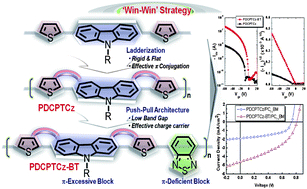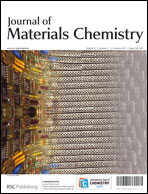A family of ladder-type π-excessive conjugated monomer (dicyclopentathienocarbazole (DCPTCz)) integrating the structural components of carbazole and thiophene into a single molecular entity is synthesized and polymerized by oxidative coupling to yield poly(dicyclopentathienocarbazole) (PDCPTCz). Moreover, through the careful selection of 2,1,3-benzothiadiazole unit as a π-deficient building block, the dicyclopentathienocarbazole-based donor–acceptor copolymer (poly(dicyclopentathienocarbazole-alt-2,1,3-benzothiadiazole) (PDCPTCz-BT)) is prepared by Suzuki polycondensation. The optical, electrochemical, and field-effect charge transport properties of the resulting polymers (PDCPTCz and PDCPTCz-BT) are not only characterized in detail but also their bulk-heterojunction (BHJ) solar cell in combination with PC71BM are evaluated. The values of field-effect mobility (µ) for PDCPTCz and PDCPTCz-BT are 8.7 × 10−6 cm2 V−1s−1 and 2.7 × 10−4 cm2 V−1s−1, respectively. A power conversion efficiency (PCE) of 1.57% is achieved on the PDCPTCz-BT/PC71BM device, implying that the push–pull copolymers based on ladder-type dicyclopentathienocarbazole as an electron-donating moiety are promising for organic electronic devices.

You have access to this article
 Please wait while we load your content...
Something went wrong. Try again?
Please wait while we load your content...
Something went wrong. Try again?


 Please wait while we load your content...
Please wait while we load your content...